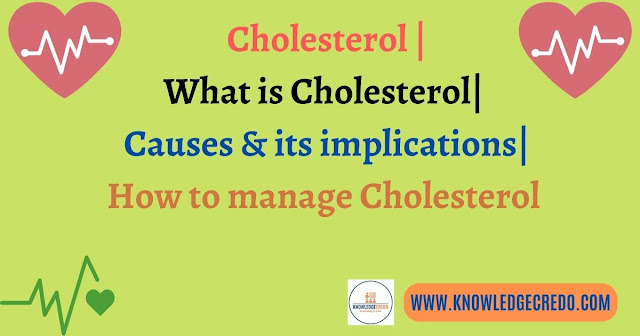Cholesterol | What is Cholesterol?| Its causes, symptoms, precautions | How to control it?
What is Cholesterol ?
Cholesterol is a waxy, fat-like substance that’s found in all the cells in your body. Your body needs some cholesterol to make hormones, vitamin D, and substances that help you digest foods. Your body makes all the cholesterol it needs. Cholesterol is also found in foods from animal sources, such as egg yolks, meat, and cheese.
Your body needs cholesterol to build healthy cells, but If you have too much cholesterol in your blood, it can combine with other substances in the blood to form plaque. Plaque sticks to the walls of your blood vessel or arteries. This buildup of plaque is known as atherosclerosis. It can lead to coronary artery disease, where your coronary arteries become narrow or even blocked. Sometimes, those deposits can break suddenly and form a clot that causes a heart attack or stroke.
 |
| What is cholesterol |
High cholesterol can be inherited, but it’s often the result of unhealthy lifestyle choices, which make it preventable and treatable. A healthy diet, regular exercise and sometimes medication can help reduce high cholesterol.
Cholesterol comes from two sources. Your liver makes all the cholesterol you need. The remainder of the cholesterol in your body comes from foods from animals. For example, meat, poultry and dairy products all contain dietary cholesterol.
Those same foods are high in saturated and trans fats. These fats cause your liver to make more cholesterol than it otherwise would. For some people, this added production means they go from a normal cholesterol level to one that’s unhealthy.
Some tropical oils – such as palm oil, palm kernel oil and coconut oil – contain saturated fat that can increase bad cholesterol. These oils are often found in baked goods.
Cholesterol Numbers and What They Mean
Your cholesterol numbers show how much cholesterol is circulating in your blood. Your HDL (“good” cholesterol) is the one number you want to be high (ideally above 60). Your LDL (“bad” cholesterol) should be below 100. Your total should be below 200.
Why are my cholesterol numbers important?
Your cholesterol numbers are important because they help you know your risk for heart disease. Cholesterol is a type of lipid (fat) that helps your body perform many important functions. But too much cholesterol in your blood is bad for you. It can enter your artery wall, damage its integrity and lead to the formation of atherosclerotic plaque (hardened deposits).
This process of plaque buildup is called atherosclerosis. It can lead to serious problems like:
Coronary artery disease: Blocked blood flow to your heart.
Peripheral artery disease: Blocked blood flow to your legs and arms.
Carotid artery disease: Blocked blood flow to your brain.
Cholesterol travels through your blood silently. And it turns into plaque silently. Plaque buildup is like someone tip-toeing on carpet. You might not see or notice its presence for a long time. You may have no symptoms until you have a heart attack or stroke. At that point, the plaque is like high heels on a hardwood floor. And it’s already caused serious damage to your body.
You can live for many years with high cholesterol and not even know it. That’s why it’s essential to get your cholesterol numbers checked on a regular basis. If your cholesterol numbers are too high (hyperlipidemia), that’s a red flag for you and your healthcare provider. High cholesterol is a major risk factor for heart disease. But catching it early gives you a chance to make changes and get your cholesterol to a healthy level.
What kind of test measures cholesterol?
You can check your cholesterol levels through a blood test called a lipid panel (or lipid profile). Your doctor take blood from a vein in your arm and send the blood to a lab for analysis. Be sure to closely follow your doctor’s instructions on how to prepare for the test. You’ll likely need to fast for 12 hours beforehand. This means avoiding all foods and drinks except water. When your results come in, your doctor will let you know. You may also be able to access your results through your electronic medical record.
Total cholesterol: This is the total amount of cholesterol that’s circulating in your blood. Here’s the formula for calculating it: HDL + LDL + 20% triglycerides = total cholesterol.
What are HDL, LDL, and VLDL?
HDL level: HDL is high-density lipoprotein. This is the “good” cholesterol that moves extra cholesterol from your bloodstream to your liver. Your liver then gets rid of it from your body. When you see HDL, think of “h” for helpful. HDLs help your arteries clear out the cholesterol your body doesn’t need. It’s the one number in your lipid panel that you want to be high.
LDL level: LDL is low-density lipoprotein. This is the “bad” cholesterol that contributes to plaque buildup in your arteries. You need some LDLs because they carry cholesterol to your body’s cells. But having too many can cause problems.
VLDL level: VLDL is very low-density lipoprotein. It’s another “bad” form that contributes to plaque buildup. VLDLs carry a type of fat (triglycerides) in your blood. If you have too many VLDLs, the extra fat can build up in your arteries.
What are triglycerides?
Non-HDL cholesterol: This is all the cholesterol in your blood that isn’t HDL. The formula for calculating this number is simple: Total cholesterol – HDL = Non-HDL cholesterol
Ratio between total cholesterol and HDL: This is your total cholesterol divided by your HDL. In general, you want your number to be below five. Your results may show a chart with more details and desirable levels.
The combination of high levels of triglycerides with low HDL and/or high LDL cholesterol levels can increase your risk for health problems, such as heart attack.
What is the unit of measurement for cholesterol?
Healthcare providers measure cholesterol levels as milligrams of cholesterol per deciliter of blood. The abbreviation is mg/dL. Providers use these same units to measure your triglycerides.
Why cholesterol matters
Cholesterol circulates in the blood. As the amount of cholesterol in your blood increases, so does the risk to your health. High cholesterol contributes to a higher risk of cardiovascular diseases, such as heart disease and stroke. That’s why it’s important to have your cholesterol tested, so you can know your levels.
Symptoms of high cholesterol
High cholesterol has no symptoms. A blood test is the only way to detect if you have it.
When to see a doctor
According to the National Heart, Lung, and Blood Institute (NHLBI), a person’s first cholesterol screening should occur between the ages of 9 and 11, and then be repeated every five years after that.
The NHLBI recommends that cholesterol screenings occur every one to two years for men ages 45 to 65 and for women ages 55 to 65. People over 65 should receive cholesterol tests annually.
If your test results aren’t within desirable ranges, your doctor might recommend more-frequent measurements. Your doctor might also suggest more-frequent tests if you have a family history of high cholesterol, heart disease or other risk factors, such as diabetes or high blood pressure.
Levels and ranges
In adults, total cholesterol levels less than 200 milligrams per deciliter (mg/dL) are considered healthy.
A reading between 200 and 239 mg/dL is borderline high.
A reading of 240 mg/dL and above is considered high.
LDL cholesterol levels should be less than 100 mg/dL.
100–129 mg/dL is acceptable for people with no health problems but may be a concern for anyone with heart disease or heart disease risk factors.
130—159 mg/dL is borderline high.
160–189 mg/dL is high.
190 mg/dL or higher is considered very high.
HDL levels should be kept higher. The optimal reading for HDL levels is of 60 mg/dL or higher.
A reading of less than 40 mg/dL can be a major risk factor for heart disease.
A reading from 41 mg/dL to 59 mg/dL is borderline low uses of cholesterol
How is high cholesterol diagnosed?
There are usually no signs or symptoms that you have high cholesterol. There is a blood test to measure your cholesterol level. When and how often you should get this test depends on your age, risk factors, and family history. The general recommendations are:
For people who are age 19 or younger::
The first test should be between ages 9 to 11
Children should have the test again every 5 years
Some children may have this test starting at age 2 if there is a family history of high blood cholesterol, heart attack, or stroke
For people who are age 20 or older::
Younger adults should have the test every 5 years
Men ages 45 to 65 and women ages 55 to 65 should have it every 1 to 2 yea
Medical conditions that can cause unhealthy cholesterol levels include:
Chronic kidney disease, Diabetes , HIV/AIDS, Hypothyroidism, Lupus
Cholesterol levels can also be worsened by some types of medications you may be taking for other health problems, such as:
Acne, Cancer, High blood pressure, HIV/AIDS, Irregular heart rhythms, Organ transplants.
Risk factors of high cholesterol
Factors that can increase your risk of unhealthy cholesterol levels include:
- Poor diet. Eating too much saturated fat or trans fats can result in unhealthy cholesterol levels. Saturated fats are found in fatty cuts of meat and full-fat dairy products. Trans fats are often found in packaged snacks or desserts.
- Obesity. Having a body mass index (BMI) of 30 or greater puts you at risk of high cholesterol.
- Lack of exercise. Exercise helps boost your body’s HDL, the “good,” cholesterol.
- Smoking. Cigarette smoking may lower your level of HDL, the “good,” cholesterol.
- Alcohol. Drinking too much alcohol can increase your total cholesterol level.
- Age. Even young children can have unhealthy cholesterol, but it’s much more common in people over 40. As you age, your liver becomes less able to remove LDL cholesterol.
Complications of high cholesterol
Development of atherosclerosis.
High cholesterol can cause a dangerous accumulation of cholesterol and other deposits on the walls of your arteries (atherosclerosis). These deposits (plaques) can reduce blood flow through your arteries, which can cause complications, such as:
Chest pain. If the arteries that supply your heart with blood (coronary arteries) are affected, you might have chest pain (angina) and other symptoms of coronary artery disease.
Heart attack. If plaques tear or rupture, a blood clot can form at the plaque-rupture site — blocking the flow of blood or breaking free and plugging an artery downstream. If blood flow to part of your heart stops, you’ll have a heart attack.
Stroke. Similar to a heart attack, a stroke occurs when a blood clot blocks blood flow to part of your brain.
Prevention from high cholesterol | How can I lower my cholesterol?
You can lower your cholesterol through heart-healthy lifestyle changes. They include a heart-healthy eating plan, weight management, and regular physical activity.
- Eat a low-salt diet that emphasizes fruits, vegetables and whole grains
- Limit the amount of animal fats and use good fats in moderation
- Lose extra pounds and maintain a healthy weight
- Quit smoking
- Exercise on most days of the week for at least 30 minutes
Drink alcohol in moderation, if at all
- Manage stress
 |
| How to manage cholesterol |
If the lifestyle changes alone do not lower your cholesterol enough, you may also need to take medicines. There are several types of cholesterol-lowering drugs available, including statins. If you take medicines to lower your cholesterol, you still should continue with the lifestyle changes.
Some people with familial hypercholesterolemia (FH) may receive a treatment called lipoprotein apheresis. This treatment uses a filtering machine to remove LDL cholesterol from the blood. Then the machine returns the rest of the blood back to the person.

